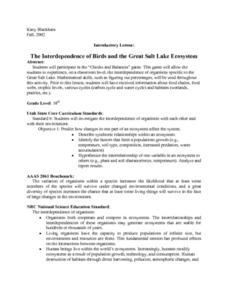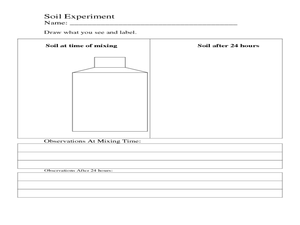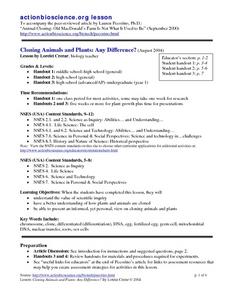Curated OER
Gathering, Traditions, and Nutrition of Our Food
Students gain a better understanding of what it means to eat seasonally through learning about traditional hunting, gathering, and food preparation methods of Athabascan tribes. By interacting with Native American Elders and...
Curated OER
Biological Control of Purple Loosestrife
Students examine the role of Purple Loosestrife in Illinois and Indiana rivers. In groups, they collect a wide variety of plants in a wetland and raise beetles in a controlled environment. They introduce the loosestrife into the...
Curated OER
Exploring the Biomes of South America
Sixth graders complete a five-week unit investigating the eight major biomes of South America. They conduct Internet research, collect short-term and long-term climate data, and create a HyperStudio slideshow stack about a selected biome...
Curated OER
Freshwater Habitats
Students take samples from local freshwater sources and examine them for macroinvertebrate life. They take samples from both shallow and deep freshwater environments, measure temperatures, and classify organisms found in their samples.
Curated OER
Dissolved Oxygen in an Aquatic Ecosystem
Students explain why dissolved oxygen is important in aquatic ecosystems. They evaluate the optimal dissolved oxygen levels for living organisms.
Curated OER
The Interdependence of Birds and the Great Salt Lake Ecosystem
Tenth graders participate in the "Checks and Balances" game. This game lets them experience the interdependence of oragnisms specific to the Great Salt Lake. They recieved informaton about food chains, food webs, trophic levels various...
Curated OER
Getting Thirsty?
Young scholars explore the concept of drought and its significance as a natural hazard. For this drought lesson plan, students complete 13 questions on an "Introduction to Drought as an Ecosystem Stressor" worksheet and discuss the...
Curated OER
Locating Echo
Students read the book The Adventure of Echo the Bat. For this animal science lesson, students read the book and create a chart labeled "Land Feature," "Habitat," and "Food." Students fill in the table according to where the character...
Curated OER
Oceans-Coral Reefs
Second graders investigate coral reefs. In this oceanology lesson plan, 2nd graders discuss what constitutes a coral reef and the wildlife that lives there. Students watch a video about coral reefs and take an online quiz.
Curated OER
Imagine a Kelp Forest
Students write a story based on their research of the kelp forest. In this ecosystem lesson, students view a video and research the kelp forest ecosystem. They write a short story imagining the discovery of a new species in the kelp forest.
Curated OER
Under Our Feet
Students investigate the forest ecosystem to learn of the living and non-living elements of the soil. In this ecosystem instructional activity, students examine soil for twigs, moss, fungi, leaves, roots and other matter. Students...
Curated OER
Fresh Produce North of 60
Teen-agers discuss how fresh produce is brought into areas that do not have agreeable growing conditions and read an article from Canadian Agriculture at a Glance. They write an essay about projects that may help provide food in these...
Curated OER
Prairie Conservation
Fourth graders conduct online research related to prairie conservation, prairie plants and animals, and the ecological system of the prairie.
Curated OER
Life at Risk
Students examine the characteristics of the peregrine falcon. They investigate endangered and extinct species, and how the environment affects the process.
Curated OER
Native Plants: An Outdoor Scavenger Hunt
Young scholars recognize various California native species by their physical appearances and characteristics. They recognize the adaptations that plants make to their surroundings and how humans make use of plants.
Curated OER
Web of Life
Learners collect information about various organisms in a forest ecosystem and create a mural that depicts organism interdependence. They then simulate a food web using a ball of string.
Curated OER
Flipbook Succession
Students review succession charts for their native area before going to an outside site to view the changes. At the site, they follow the transect line and observe the changes in the plant life. They draw the changes on note cards that...
Curated OER
Field Biology
Students work with 4th and 5th graders at Cascade Brook School in Farmington, to teach them skills in wildflower and fern identification, and then to help them implement a nature trail, which is accessible to the greater Farmington...
Curated OER
Algae Experiments
Students describe the characteristics of algae. In this biology lesson, students perform a series of experiment to explore algae. They investigate the basic things algae need to survive.
Curated OER
Co-evolution of Plants and Pollinators
High schoolers, while studying the rolls of pollinators and plants, explore co-evolution of mutualistic relationships.
Curated OER
Invasive Species
Students study exotic and native species, and examine how exotic species can impact native ones. They study how the mute swan effects native species.
Curated OER
Cloning Animals and Plants: Any Difference?
Students examine the process in which plants and animals are cloned. They compare and contrast the two procedures and determine if there is a difference. They share their views on cloning to the class.
Curated OER
"The Good, The Bad, and The Smelly."
Students explore insects' use of pheromones and beneficial insects versus insect pests.
Curated OER
The Seasons of Thanks
First graders explain the Native American cyclical concept of time

























